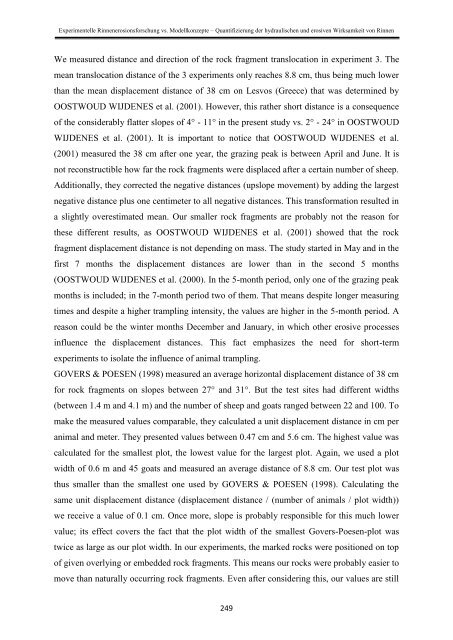Stefan Wirtz Vom Fachbereich VI (Geographie/Geowissenschaften ...
Stefan Wirtz Vom Fachbereich VI (Geographie/Geowissenschaften ...
Stefan Wirtz Vom Fachbereich VI (Geographie/Geowissenschaften ...
You also want an ePaper? Increase the reach of your titles
YUMPU automatically turns print PDFs into web optimized ePapers that Google loves.
Experimentelle Rinnenerosionsforschung vs. Modellkonzepte – Quantifizierung der hydraulischen und erosiven Wirksamkeit von Rinnen<br />
We measured distance and direction of the rock fragment translocation in experiment 3. The<br />
mean translocation distance of the 3 experiments only reaches 8.8 cm, thus being much lower<br />
than the mean displacement distance of 38 cm on Lesvos (Greece) that was determined by<br />
OOSTWOUD WIJDENES et al. (2001). However, this rather short distance is a consequence<br />
of the considerably flatter slopes of 4° - 11° in the present study vs. 2° - 24° in OOSTWOUD<br />
WIJDENES et al. (2001). It is important to notice that OOSTWOUD WIJDENES et al.<br />
(2001) measured the 38 cm after one year, the grazing peak is between April and June. It is<br />
not reconstructible how far the rock fragments were displaced after a certain number of sheep.<br />
Additionally, they corrected the negative distances (upslope movement) by adding the largest<br />
negative distance plus one centimeter to all negative distances. This transformation resulted in<br />
a slightly overestimated mean. Our smaller rock fragments are probably not the reason for<br />
these different results, as OOSTWOUD WIJDENES et al. (2001) showed that the rock<br />
fragment displacement distance is not depending on mass. The study started in May and in the<br />
first 7 months the displacement distances are lower than in the second 5 months<br />
(OOSTWOUD WIJDENES et al. (2000). In the 5-month period, only one of the grazing peak<br />
months is included; in the 7-month period two of them. That means despite longer measuring<br />
times and despite a higher trampling intensity, the values are higher in the 5-month period. A<br />
reason could be the winter months December and January, in which other erosive processes<br />
influence the displacement distances. This fact emphasizes the need for short-term<br />
experiments to isolate the influence of animal trampling.<br />
GOVERS & POESEN (1998) measured an average horizontal displacement distance of 38 cm<br />
for rock fragments on slopes between 27° and 31°. But the test sites had different widths<br />
(between 1.4 m and 4.1 m) and the number of sheep and goats ranged between 22 and 100. To<br />
make the measured values comparable, they calculated a unit displacement distance in cm per<br />
animal and meter. They presented values between 0.47 cm and 5.6 cm. The highest value was<br />
calculated for the smallest plot, the lowest value for the largest plot. Again, we used a plot<br />
width of 0.6 m and 45 goats and measured an average distance of 8.8 cm. Our test plot was<br />
thus smaller than the smallest one used by GOVERS & POESEN (1998). Calculating the<br />
same unit displacement distance (displacement distance / (number of animals / plot width))<br />
we receive a value of 0.1 cm. Once more, slope is probably responsible for this much lower<br />
value; its effect covers the fact that the plot width of the smallest Govers-Poesen-plot was<br />
twice as large as our plot width. In our experiments, the marked rocks were positioned on top<br />
of given overlying or embedded rock fragments. This means our rocks were probably easier to<br />
move than naturally occurring rock fragments. Even after considering this, our values are still<br />
249
















